A lack of transparent reporting masks high damage rates in India and China, but as consumer expectations shift there should be a big market for PDI and smart repair in these markets, reports Maxine Elkin
It would, on the face of it, seem a logical assumption that the demand for smart repair and PDI operations in India and China should be very high. The relatively poor infrastructure, long distances transported and immature finished vehicle logistics market combine to create a damage-rich logistics supply chain. But it is not quite that simple.
Whenever you look at the smart repair market, quality expectations are crucial–expectations of the OEMs, expectations of the dealers and, most importantly, the expectations of the final customers. And none of these are quite the same in these markets as you might expect in Europe or the US. The sheer growth of demand for vehicles in China and India means that quality is still a secondary consideration. Tata, for example, had sold 100,000 Nanos before the first one had rolled off the assembly line. In these conditions, customers may be more content just to get their vehicle and more willing to accept minor damages than customers in other markets. Besides this willingness, dealerships are extremely generous with extras to compensate for minor transport damage, such as under-body rust coating and extra painting with clients, according to VG Ramakrishnan, a consultant at Frost and Sullivan, because they want to score well in the JD Power surveys.
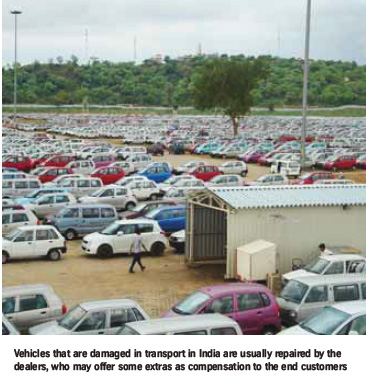
Importantly, there is also a sharp distinction in China and India between treating export vehicles and vehicles for domestic consumption, with more rigorous damage inspection and repair carried out for exports. But expectations are also evolving. Bosch Virdi, commercial director at GBA Group, which is managing the export of 35,000 cars a year for Tata and Maruti Suzuki through Mumbai port, observes: “I think the delivery of quality is critical, because of increasing volumes being exported from India to global markets and the demands on quality is rapidly rising through the logistics chain. Customer expectations have to be met by both carmakers and logistics providers.”
Domestic vehicles: unreported repairs In India, there are currently 3PLs moving in to service the business. Mosolf is now VW’s releasing agent, GBA has operations at Mumbai port and is seeking to expand, and Wallenius Wilhelmsen Logistics (WWL) is dipping a toe the market. These companies bring with them handling processes and the quality expectations of mature markets. The same pattern is seen in the Chinese market. But for vehicles produced and sold domestically, the PDI and repair processes are different.
For domestic vehicles in India and China most of the minor repairs are done by workshops at the dealerships, and if the
repair is more serious the OEMs handle it. According to a source (who asked not to be identified), “There is a difference between China and India because you sell more premium quality cars in China than in India such as the Mercedes S class, and so on. These cars are more likely to be repaired using high-quality smart repair methods. From this point of view China is a little ahead of India because of the volumes of cars [being repaired].”
But determining the size of this market in both countries can be problematic because the damage rates are not accurately reported. Since the dealerships handle the repairs of the vehicles that do not pass the PDI inspection, the carmakers are often unaware their products have been damaged.
The anonymous source, who has worked in both markets for an LSP says: “In the global automotive industry when
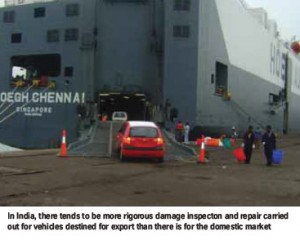
vehicles are transported by vessel, train or truck usually there is a damage rate between 0.1% and 2%, or something similar. India is the only country where they have 0% damage. This is because the transport companies take the cars, damage them, and because they want to keep the business with the OEM, the dealerships repair the damage without reporting it. The real damage rate is at least 10-15%.”
The carmakers, both he and Ramakrishnan reveal, are generally aware this is happening but do not see it as a problem if there is no obvious cost to them. This could, however, cause problems as the quality expectations of Indian consumers rise. Ramakrishnan says: “Many times it has happened that the dealers’ mechanics [who have fixed the cars] have left the job card inside the car when it is delivered to the customer and this creates a lot of litigation.”
Most of the damage to vehicles transported in India and China is because of bad handling and poor driver education, as well as having the wrong equipment. One source reveals that doors tend to get damaged because the transport truck is not wide enough, meaning the driver must enter the car through the window. In China a source also reports cars even being secured to transporters using ropes.
With repairs to cars damaged in transit done by the dealers, there are little or no smart repair operations in place for domestic cars. But according to Ramakrishnan some logistics companies do have specialist polishers or mechanics that can fix minor damages. But the market is evolving, and on the export side, operations are quite different.
PDI work is important for exports
GBA is performing PDI operations in the port of Mumbai and Virdi explains the process is different to PDI operations in other locations: “PDI in India can consist of anything from doing a smart repair to washing a car, inspection of vehicles for transit damage or anything associated with preparing the car for export.”
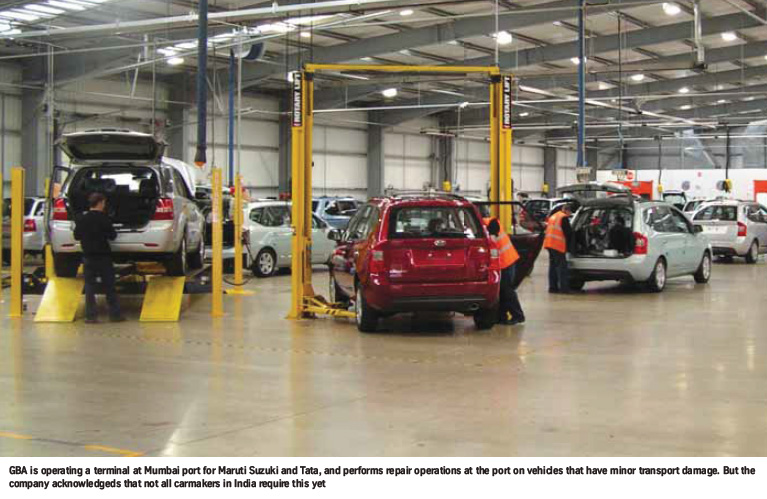
NMCI Inspections & Survey India, part of the US-based NMCI Group Worldwide, will commence PDI inspections for vehicles exported through Mumbai Port. NMCI was recently nominated to be the inspectors for the carriage and movement of the small number of Mahindra & Mahindra cars planned for export by WWL to the US at both Mumbai Port and at the discharge point in Brunswick port, in Georgia. Though the contract is still pending, NMCI is also in consideration for doing the PDI at the origin plant in Nashik. Captain Deepak Guha, managing director of NMCI India, reveals that if the company takes over this contract it will perform PDIs inside the factory at Nashik, at the Frere basin in the port of Mumbai as well as Brunswick, and another location at the dispatch area prior to loading the vessel in Mumbai.
“The possibility of minor damages cannot be ruled out due to additional handling and of course increased costs hence we insist on a final PDI at the vessel side,” Guha says. According to Captain Guha, few ports in India currently have any dedicated ro-ro terminal except for Adani Mundra Automobile Terminal in Gujarat. A dedicated terminal is also expected to open shortly at the port of Ennore, near Chennai. For now, however the terminal in use at Mumbai is an old passenger berth terminal, which causes problems for the storage and movement of vehicles within the port area. The cars are often moved multiple times after arrival at the city and before export, while PDI has to be taken after every movement to ensure no damage has occurred. If there is damage, also known as “exceptions”, it is logged and the relevant parties are informed.
NMCI uses hand-held PCs to log the inspections using the VIN number to identify the vehicle. “We use the software and PCs to record the exceptions and we tend to see these in 2-3% of the cars. Then we record the damage types, the location, the parts, the cause, and we take photos of all the exceptions and the corresponding VINs. We also make a note of the exceptions that are not covered by the software, such as the fog lights and the mudguards.”
According to WWL, Mahindra & Mahindra will only export 500 cars initially to the US, and if it is successful the numbers may increase to 1,000 cars per year or more. The GBA Group, meanwhile, is operating a terminal at Mumbai port, which is being used by Maruti Suzuki and Tata. For Tata, the company inspects the vehicles at the plants for build standards before transporting the vehicles to Mumbai port and inspecting them before export.
GBA performs smart repair operations at the port on vehicles that have minor transit damage. Virdi says: “We are doing similar smart repair operations to the ones in Europe, things like dent removal and fixing scratches. Because of the warranty requirement on new cars, smart repairs are restricted to a few small activities.”
Virdi acknowledges that the smart repair operations and certain streamlined handling and inspection processes used are new to the Indian market. “Not all vehicle manufacturers are following that trend and it may take them some time to go down that route.”
But he also believes that the domestic market is complicated. “There is a distinct difference between the export market and domestic vehicles–the domestic market will accept certain faults on cars that would not be accepted on export vehicles,” he says.
Limited technical paint repair in PDI centres
The dealerships do paint work in India, although in most cases only carmakers have the proper infrastructure for this, including ovens and clean, high quality painting rooms that have the right climate. It is to this dealer market that paint companies such as Akzo Nobel are keen to introduce its products. Barry Edney, the company’s commercial services manager for Asia explains: “When you go to new, emerging markets like China and India–and this is distinct from other markets–you will find PDI centres but they will not do technical services or paint work. Whenever a car arrives to India and China, the dealers will mostly repair those cars. Cars arrive, damage is logged in and the dealer receiving will repair the car.”
Edney also explains that for these markets Akzo Nobel remains in close contact with both the manufacturers and the independent market to support the market in terms of productivity. “When you go to the dealer segment, you will find larger shops, but when you look into the independent segment, they are quite small,” he says. According to Edney, the range of products sold in India and China differs from those sold in more mature automotive markets because of environmental legislation in the West which has led to the development of waterborne products to replace the solvent-based products (which contain volatile organic compounds). The newer, waterborne paints also have a higher degree of colour accuracy, which is directly related to quality expectations for customers.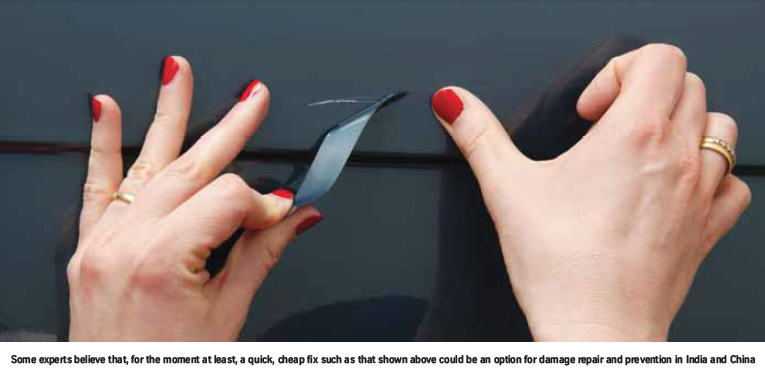
In Edney’s experience, PDI centres have two priorities: productivity, as the speed of processes and throughput is what makes these centres successful; the other is colour accuracy, since the cars are brand new and must be in pristine condition before delivery. “This is why it is so crucial that you have modern products and good training when it comes to repair technology,” he says.
At the moment you will struggle to find a PDI centre doing technical paint repair work in India or China, but that will change, believes Carsten Mann, a strategic key account manager at Akzo Nobel. “In future as more cars are transported or delivered to those markets, more productivity will have to be gained in the whole production process,” Mann says. “In Europe and the US you have those repair centres because they can be more productive and they are specialised on very small repairs. They call this ‘smart repair’ technology, with specifically designed product systems and trained people focussing on small repairs with a small impact on nondamaged parts of the car such a panel or hood.
“This type of market will definitely come in India and China,” he predicts. Mann believes that it will follow the model of the Turkish market. “Now in Turkey they have started building PDI centres with technical and paintwork services in those centres, and the more cars being imported to those markets, the more there will be a need for high productive repair flow. It has to be like a production line with cars lined up for repair in a specific manner in order to make the whole process very efficient.”
A quick fix
In China most companies are also using solvent-borne solutions. However there are more rapid repair technologies available at specific dealers. In India this technology is being introduced into the market, but its use depends on the type of cars being repaired or how much a scratch would disturb the driver, as well as how much the driver will look for a high quality repair at a competitive price.
One Akzo Nobel product line that could have wide application in India and China is the StickerFix product (pictured above). It is being offered as a preventive solution on painted area of cars that are prone to damage, such as doors, bumpers and mirrors. The Stickerfix film is supplied to the dealerships pre-painted with the original body colour and can be cut to any shape required. In India bumpers are often fitted to the cars unpainted and then painted at the dealers before delivery, but the colour accuracy of dealer paint jobs tends not to be as high as factory painting.
Akzo Nobel is targeting this at fleet and rental companies, but there would seem to be applications for such technology in high-damage environments. It was launched last year in Europe where Akzo Nobel supplies the transparent film to repair shops, and when the major repair is done, the film is sprayed with the car colour and is offered to the owners as an alternative to the small bottles of paint to mend minor scratches.
Paint-less technology
Paint-less repair is the most common type of smart repair operation because the integrity of the paintwork is very important to carmakers with new vehicles. One company targeting India and China as potential markets is the Italian hail repair company Ballsystem, which specialises in repairing hail damage to new vehicles and training people in the methods they use to perform repair to dents. The company has an operation in Shanghai, which is already doing research, training and offering consultancy services. It aims to be in full operation by 2011. Felicio Fiorenza, the company’s strategic director, confirms: “We already operate consultancies for OEMs and LSPs and are focusing on the Ballsystem Academy in which we are training people in China in our techniques.”
Hail occurs mostly in the countryside in China, so actual repair work has been limited, but as China’s automotive market spreads out of the major cities the need for trained hail-repair specialists will certainly increase. Already carmakers are beginning to target rural markets, which saw fast sales growth in China last year, and distribution centres are being built and planned well beyond the major cities of Beijing and Shanghai.
According to Carlo Travaglini, Ballsystem’s key account manager, the growth of automotive sales in these markets will lead to an inevitable increase in damages. Ballsystem is looking for a logistics partner in India to help it move into the damage repair market too.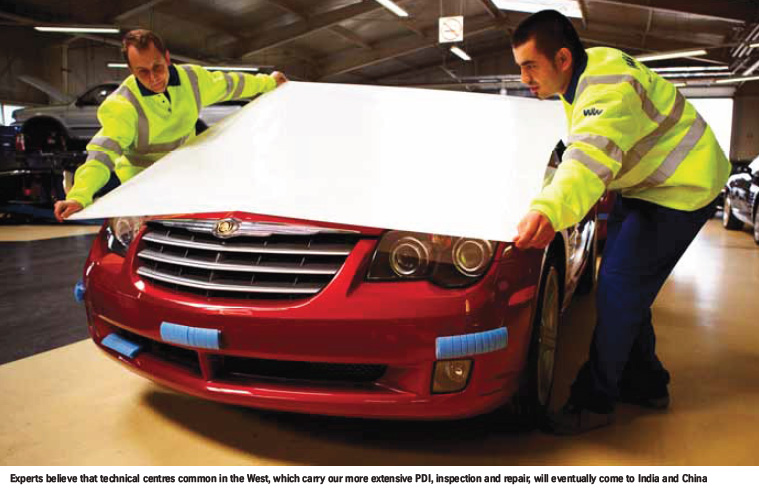 Interestingly, the value of the vehicles does not affect the price of repair, which could have posed a barrier to entry to China and India given the relative low cost of domestically produced vehicles. According to Carlo Mottola, operations director, it is the size of the vehicle and the material from which it is made that affects the price, along with the time taken to do the job. Aluminium vehicles, for example, are more costly to repair because it is a more difficult material to work with. “It takes 1/3 longer to repair than the average damage time,” he says.
Interestingly, the value of the vehicles does not affect the price of repair, which could have posed a barrier to entry to China and India given the relative low cost of domestically produced vehicles. According to Carlo Mottola, operations director, it is the size of the vehicle and the material from which it is made that affects the price, along with the time taken to do the job. Aluminium vehicles, for example, are more costly to repair because it is a more difficult material to work with. “It takes 1/3 longer to repair than the average damage time,” he says.
A future for smarter repair
It is evident that vehicles are being damaged in transport in India and China, and as the market matures and customer expectations rise, carmakers are likely to replicate the Western pattern of taking back control over the quality of the finished product delivered to an increasingly discerning group of customers. Many commentators see the larger logistics companies introducing smart repair and modern PDI processes as they gain ground in the fragmented fleets of China and India, but local conditions will influence the rate and shape of the smart repair business.
It is common for cars to get dented or scratched driving around India every fortnight. With more traffic coming onto the roads the situation will almost certainly get worse–so will the expectations of quality rise enough to make smart repair operations commonplace?
NMCI’s Captain Guha sees a parallel with the development of the container repair market and smart repair operations for cars. “I spent 20 years in container repair. It is a good business. In India smart repair is a nascent business. If I were a little younger I would go for it. There are not many players in the field today and that is how it was 30 years ago for container repair. Now it is flooded with repairers.”
However Captain Guha hastens to add that the car repair industry will likely be different, as primarily OEMs and logistics providers will dominate it. “Hence, I do not see many larger private partners getting involved in smart repair operations,” he says.
But the perception of quality will have to change. The unnamed source says: “When we say to the Chinese or their counterparts in India, ‘there are two dents in this vehicle’, they say ‘I don’t see any dents’.”

























![Global[1]](https://d3n5uof8vony13.cloudfront.net/Pictures/web/a/d/s/global1_726550.svgz)









